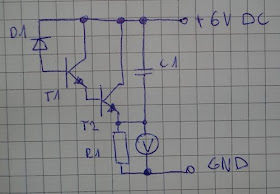A photo diode is a PN junction or PIN structure that when light reaches the junction, it excites an electron thereby creating a free electron positively charged. This mechanism is also known as the photoelectric effect, common in transistors, diodes and ICs are made of semiconductors, and contain PN junctions. Almost all of the potentially active constituents are a photo diode and may be used as a photo sensor. The PN junction needs to be exposed to light, so to use a semiconductor diode as a light bulb must have a transparent glass, these diodes with these characteristics can be used to measure the light intensity.
a test circuit diode light sensor
List of components:
D1 1n148 or any other photo-sensitive element
T1, T2 BC548 or similar
C1 680n
R1 2M
Above this circuit that is very popular, it works with LEDs, photodiodes and photo-resistors. V is a voltmeter which can be a multimeter.



No comments:
Post a Comment